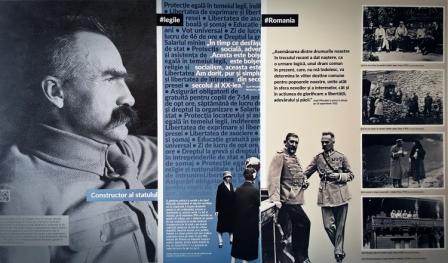The photo-documentary exhibition „Józef Piłsudski - a Polish and European statesman" was organized by the Polish Institute in Bucharest and the Embassy of Poland to the Republic of Moldova on the occasion of the celebration of the centenary of the regaining of independence of Poland.
The exhibition has sixteen stands on display with reproductions of documents, photographs, maps, military operations plans and texts prepared by the Józef Piłsudski Museum in Sulejówek, Poland, and evokes the personality of Józef Piłsudski (1867-1935), a renowned commander and statesman without whom Poland would not return to the map of Europe.
Józef Klemens Piłsudski was born on December 5,1867 in Zułowo (today Zalavas, on the border between Lithuania and Belarus) near Vilnius. He was the fourth child of small landowners Józef Wincenty and Maria Bilewiczówna. His parents had suffered deeply from the defeat of the Polish Revolution of 1863 which was directed against the Tsar occupation regime (his father had been commissioner of the Polish National Government). This feeling was passed to the young Joseph and marked his destiny forever. In the history of Poland of the twentieth century there is no other more known personality than Marshal Józef Piłsudski (1867-1935). The famous commander is the symbol of Poland's independence conquered in 1918. This happened after 123 years of so-called annexations, namely divisions of the Polish lands between Russia, Prussia and Austria, which conquered them three times and attempted to deprive the Poles not only of their homeland but also of their language, traditions and culture.
Piłsudski played a decisive role in the configuration of Poland after World War One. Enjoying a tremendous international appreciation, the leader was at the head of the newly revived Polish state, set up the army and created its democratic foundations (for example, in November 1918 he recognized women's right to vote). He later ruled with an iron hand, provoking not once controversy and admiration even among his opponents.
Józef Piłsudski also has great merits for the whole European continent. In 1920, with the victory of the Battle of Warsaw, known in Poland as the “Miracle on the Vistula”, he not only defended his own country, but also defended Europe against the Bolsheviks for several decades.
Józef Piłsudski was a friend of the royal family of Romania, he was in Romania for long vacations and four times during official visits (1922, 1928, 1931, 1932). The historian Nicolae Iorga, in the preface of an edition of Marshal J. Piłsudski’s works translated into Romanian and published in Bucharest in 1936 mentioned: “The Polish hero, the founder and the state leader, so simple and so great, precisely because he was so simple, so far away from all human weaknesses, without a sense of wealth, without passion for glory…”
 31 August 1989 St., 121 A, MD 2012, Chisinau, Republic of Moldova
31 August 1989 St., 121 A, MD 2012, Chisinau, Republic of Moldova



















































